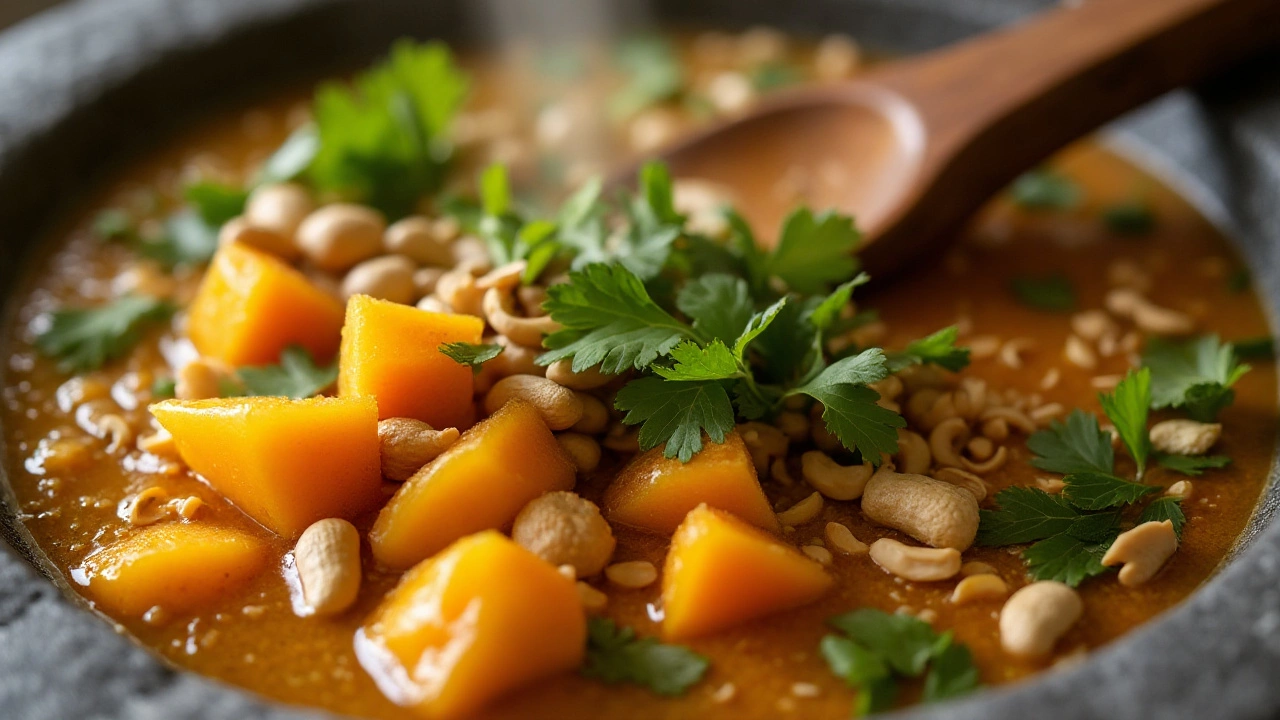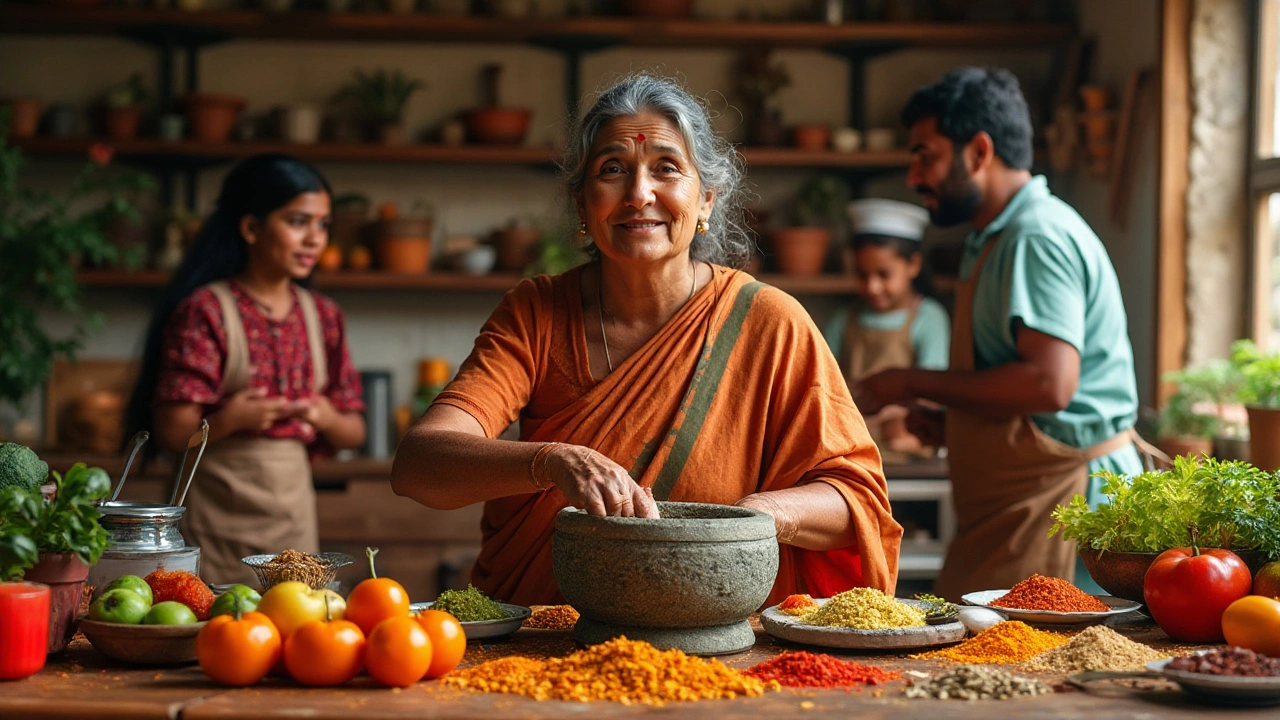Chutney, with its roots deeply embedded in the rich tapestry of Indian cuisine, has emerged as a beloved addition to tables across the globe. From being a companion to the classic samosa to now finding itself alongside roasted dishes in Western cuisines, chutney has undergone an intriguing evolution.
In this piece, we will embark on a flavorful journey exploring how chutney transcended its traditional boundaries to become a universal condiment. Whether you're an experienced cook eager to experiment or someone just venturing into the world of chutney-making, this article promises to offer inspiration and insight.
- The Origins and Evolution of Chutney
- Chutney's Global Influence
- Creating Your Own Chutney
- Tips for Perfecting Chutney Recipes
The Origins and Evolution of Chutney
Chutney's tale is as rich and varied as the lands from which it hails. This delightful condiment, often seen as an accompaniment to many traditional Indian meals, traces its lineage back to ancient times. The word 'chutney' itself comes from the Hindi word ‘chatni,’ signifying a spice mixture, a name fitting for what is a blend that can include fruits, spices, herbs, and other flavor enhancers. Historically, chutneys were made by grinding fresh ingredients using a stone mortar and pestle, a labor of love that many Indian households persist with even today.
The oldest records of chutney recipes point to the 500 BC where early methods included preserving the piquant concoction with vinegar, sugar, and salt in clay jars. This not only added flavor but also ensured longevity, which was crucial in times without refrigeration. As Indian merchants and travelers embarked upon journeys, they carried this precious condiment with them, leading to its introduction across different territories. By the 17th century, chutney became an object of fascination and adaptation in Europe, owing largely to the spice trade routes.
Colonialism also played a significant role in chutney’s spread beyond the Indian subcontinent. The British, in particular, became enamored with Indian chutneys, leading to efforts to recreate these at home with native British ingredients. A document from the era amusingly describes how these 'East Indian Pickles' became all the rage at social gatherings. This led to the modern variants such as the sweet, chunky mango chutney that many in the western world recognize today. It’s fascinating how the method and ingredients have adapted yet preserved the essence of the original.
Given the diverse regional cuisines across India, each state—almost every household, in fact—boasts its own unique twist on the classic. From the fiery red chili chutney of Andhra Pradesh to the luscious coconut variants in Kerala, these blends capture the essence of local agricultural produce and cultural preferences. It's not uncommon for a North Indian chutney to favor a tangy tamarind base, while its Southern counterpart might be thyme-inspired lime. Indian cuisine is intensely regional and chutneys embody this variety beautifully.
Today, chutney has gained prominence in numerous global cuisines, cherished by chefs and home cooks alike for its ability to elevate everyday meals with just a dollop. In 2023, an interesting survey reported that while 65% of global cooks regard a jar of chutney as indispensable, only half can perfectly balance the complex flavors essential for an authentic taste. Chutneys now adorn charcuterie boards, grace seafood dishes, and even find themselves pairing with artisanal cheeses. It's a testament to how a humble side dish has woven itself intricately into culinary fabrics worldwide.
In the words of celebrated chef Madhur Jaffrey, “Chutneys are the embodiment of the Indian palate—the symmetry of sweet, sour, tangy, and spicy.”
“The charm of a chutney lies in its playfulness, its ability to have a dance of flavors that both warms and excites the senses,” she once remarked.Whether slathered on a sandwich or mingling with rice and curry, chutneys continue to captivate taste buds, proving time and again that they are much more than mere sides to a main course.

Chutney's Global Influence
Chutney, originally a traditional Indian condiment, has traveled far beyond its origins, weaving its zesty charm across various global cuisines. The journey of chutney from local kitchens in India to being a pantry staple in homes around the world is both fascinating and delightful. Historically, chutneys were a creative way to utilize seasonal fruits and vegetables, combining them with spices, vinegar, and sugar to create a lasting preserve. As the British colonial presence expanded in India, this flavorful relish piqued their interest, and soon chutney began its journey to the Western world. British cooks started experimenting with the recipe, adapting local ingredients to recreate the tangy taste and marrying it with their culinary traditions.
The spread of chutney didn't just stop with the British Isles. With continuous waves of immigration from South Asia, especially in the mid-20th century, chutney began to appear on restaurant menus and in culinary circles in Europe, North America, and beyond. It was embraced not only for its taste but also for its versatility. As a condiment, it complements a variety of dishes, from simple sandwiches to roasted meats. The adaptability of chutney’s ingredients to different tastes and traditions made it a perfect candidate for fusion cuisine.
The BBC's Good Food Magazine once stated, "Chutney's appeal is in its ability to add complexity to even the simplest of dishes, transforming everyday meals into a gourmet experience."
In the United States, chutney found a special place during the holiday season. Cranberry chutney, for instance, has become a popular alternative to traditional sauces served at Thanksgiving. Each country seems to have put its unique spin on chutney recipes, incorporating regional fruits and spices to develop new flavor profiles. The interest in artisanal and craft food products has also sparked a resurgence in making homemade chutneys. It allows food enthusiasts to experiment with textures and intensities, creating their own signature versions of this beloved condiments.
As part of this global journey, chutneys have diversified beyond expectation. Imagine a table set with a variety of chutneys; mango chutney from India, spicy tomato relish from South Africa, or a bright cilantro-based chutney from Mexico. Each offers a specific taste and represents a cross-cultural culinary exchange. The growing trend of international food festivals and online culinary communities has further spotlighted chutney, encouraging amateur chefs and food lovers to exchange recipes and dive into the world of DIY condiment making.
Chutney in Contemporary Cuisine
Today, chutney's influence can be seen in many modern culinary practices. It's not unusual to find chefs experimenting with combining local and exotic ingredients to create newer and more exciting chutney flavors. The simplicity of making chutney—just the right mix of fruits or vegetables, sugar, spices, and a splash of vinegar—means its adaptation is limited only by imagination. The movement towards sustainable eating has also given rise to individuals making homemade chutneys, minimizing food waste and celebrating seasonal produce.
Whether as a spicy dip to enliven a cheese board, a sweet-tart drizzle over a savory tart, or an accompaniment to grilled dishes, the versatility of chutney continues to charm taste buds everywhere. It's a testament to how a humble condiment can travel across borders and cultures, maintaining its essence while undergoing a vibrant transformation to suit diverse tastes and culinary practices.

Creating Your Own Chutney
Diving into the world of chutney recipes can be an exciting culinary adventure, filled with flavors and tantalizing tastes. At its heart, chutney is a versatile concoction that lets you experiment with a variety of ingredients, crafting something that's uniquely yours. To start your chutney journey, it is essential to understand the balance of flavors that make a chutney stand out. The interplay of sweet, sour, and spicy flavors is what gives chutney its characteristic taste profile. You can choose from fruits like mangoes, tomatoes, or tamarinds for sweetness and tanginess, while ingredients such as chilies, pepper, or ginger add that necessary spice kick.
When planning to make your own chutney, think about the base you want to start with. Mango chutney is popular with its sweet and slightly tart flavor, perfect for pairing with savory dishes. On the other hand, tomato chutney is all about that punch of umami and richness. Once the base is selected, consider adding accent flavors through spices. Cumin, mustard seeds, and turmeric are common in Indian condiments, bringing warmth and earthiness to the mix. Don't shy away from experimenting with these, as the right combination can bring out hidden layers of flavor.
A vital aspect of crafting the perfect chutney is the method of preparation. Begin by sautéing spices in oil until fragrant, which helps release their essential oils, enhancing the depth of flavor in the finished product. Next, add your main ingredient like fruit or vegetables, and let it soften in the spiced oil. Balance the taste with vinegar or lemon juice for acidity and sugar to bring in sweetness. Once cooked, chutneys can be blended to achieve a smoother consistency or kept chunky for texture. Consider the consistency you prefer and adjust cooking time accordingly.
Madhur Jaffrey, a respected authority on Indian cooking, once said, "Chutneys are like little explosions of delight that can transform any simple meal into a festive affair." This encapsulates the transformative power that chutneys can bring to your dining table. It's about infusing every bite with a complex array of flavors that linger, making even the simplest meal memorable.
To illustrate the traditional balance, here's an example chutney recipe using mangoes:
- Ingredients: 2 ripe mangoes, diced; 1/2 cup cider vinegar; 1/2 cup brown sugar; 1 finely chopped onion; 1 teaspoon mustard seeds; 1/2 teaspoon cayenne pepper; salt to taste.
- Steps: In a pan, heat oil and add mustard seeds. Once they pop, add onions and saute until translucent. Add mangoes, vinegar, sugar, cayenne, and salt. Stir occasionally and cook until mangoes break down and the mixture thickens.
- Serving Suggestion: This can be served with grilled meats or simply as a spread over your morning toast.
Creating a homemade chutney is more than just a recipe; it's about embracing creativity and adding your touch to a time-honored Indian condiment. Whether you follow a recipe to the letter or stray into uncharted territory with new ingredients, the joy of chutney-making lies in its endless possibilities. Enjoy the journey of flavors, for it is as rewarding as the destination itself.

Tips for Perfecting Chutney Recipes
Creating the perfect chutney is both an art and a science. The essence of this flavorful condiment lies in balancing its trio of primordial flavors: sweet, spicy, and tangy. A successful chutney should harmonize these elements without letting any one characteristic overpower the others. Start by selecting fresh, high-quality ingredients because the better your base ingredients, the more vibrant and appetizing your chutney will be. When choosing spices, fresh ground options will bring robust and nuanced tastes to your recipe, ensuring the spicy dips stand out.
When it comes to consistency and texture, think about how you want your chutney to complement your main dish. A smooth mango chutney complements grilled meats magnificently, whereas a chunky tomato variety pairs well with cheese platters. If you're customizing texture, remember to adjust your cooking times. For instance, longer simmering for fruit-based chutneys will naturally thicken them while intensifying the sweetness. Using a blender or food processor can achieve silky finishes, especially in spicy dips designed for spreads.
Acidity is a vital player in any chutney recipe. It underscores the tangy aspect that defines many chutneys. Incorporate natural acids like lemon juice or vinegar to cut through sweetness and draw out flavors. Play with ratios to prevent your chutney from being too sharp. A spoonful of sugar or honey can counter striking tangs if an ingredient does slip through with too much intensity. Experimenting is part of the chutney experience, and even a misstep can forge a unique creation.
"A perfectly balanced chutney ignites the palate with a symphony of sensations," mused acclaimed chef Madhur Jaffrey. "It dances between flavors, turning ordinary dishes into extraordinary experiences."Cooking times vary across chutneys, depending on ingredients. For chutneys with firm fruits like green apples or unripe mangoes, ensure they're cooked until soft to achieve the desired mouthfeel. Rapid cooking may preserve freshness but also leaves chunks that overpower a bite's intended balance. Taste as you go to mold the eventual medley of flavors.
Enhancing the Spice
For those wishing to dial up the heat, consider the method of infusing the spice. Fresh chilies offer a bright, raw heat, while dried chili flakes add a deeper, smokier dimension. When using powdered spices, lightly toasting them beforehand can enhance their essence significantly, bringing forth headier aromas that enrich your concoction deeply. Don't shy away from mixing different chili varieties for layers of spice complexity. A tip here is to pace the spice level incrementally—you can add more, but you can't take it out.
Finally, storing chutney correctly ensures longevity and intensifies flavors over time. Use sterilized jars to prevent the growth of bacteria. Once opened, refrigerate and use within stipulated times for peak freshness. Over time, the flavors in your chutney recipes meld, and what was complex transforms into a smoother melange. With these insights and techniques, your chutney can become the shining star of any meal, captivating all those seated at your table.
